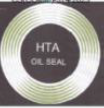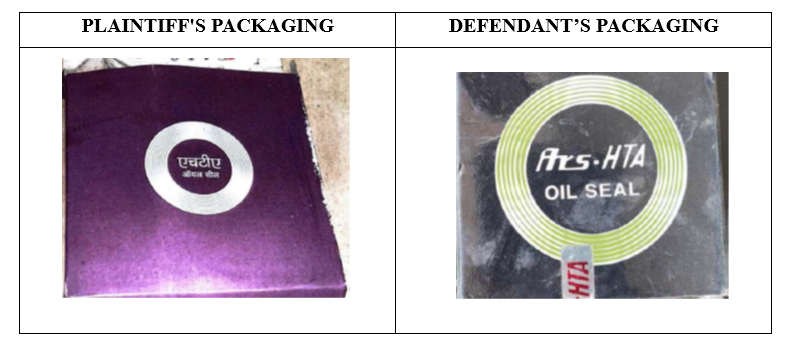Trademark conflicts frequently revolve around striking a careful equilibrium between the privileges of registered users and the assertions of prior users. When addressing requests for injunctions, the judicial system closely scrutinizes whether there has been a violation or misleading imitation of intellectual property rights and whether these actions by the purported infringer might result in confusion or deception. In the notable case of Paul Components v. Hi-Tech Arai, the Delhi High Court meticulously analyzed this legal doctrine, taking into account the legal rights conferred upon registered intellectual property users compared to those of prior users.
Facts:
The Plaintiff (Paul & Paul Components) claimed that they were the registered proprietor for  and asserted continuous usage of said marks since the year 1977 in connection with oil seals and rubber components utilized in vehicular applications. The Defendant (Hi-Tech Arai) claimed that they have been using the marks HTA, ARS-HTA and
and asserted continuous usage of said marks since the year 1977 in connection with oil seals and rubber components utilized in vehicular applications. The Defendant (Hi-Tech Arai) claimed that they have been using the marks HTA, ARS-HTA and  since 1985 for oil seals that were bought by vehicle manufacturers and Original Equipment Manufacturers. The exhibits of the packaging of the products depicting the rival marks are shown below.
since 1985 for oil seals that were bought by vehicle manufacturers and Original Equipment Manufacturers. The exhibits of the packaging of the products depicting the rival marks are shown below.

The Plaintiff submitted that they are the registered proprietors of the mark and have been using the mark prior to the date of usage by the Defendant and are therefore the prior users of the mark. The Defendants submitted that the Plaintiff has fabricated evidence to pre-date the first use of the mark by the Plaintiff and that therefore the claim of the Plaintiff is liable to be dismissed due to the lack of substantial evidence.
In this judgment, the Court considered the rights of a registered user, the likelihood of confusion and the rights of a prior user in determining the possibility of granting an injunction.
Plaint Submissions:
The Plaintiff claimed to be users of the mark since 1977 and in order to substantiate their claim of usage since 1977 they submitted (i)invoices from 1977-2023, (ii)notices from dealers, (iii)company calendars printed by Paul and Paul bearing the HTA mark, (iv)photos from Auto Expos where the Plaintiff has used the mark HTA on their banners and (v)official communications made by the Plaintiff-company.
The Plaintiff submitted that the Defendant began using the mark HTA only in 2020 and that the same is supported by the apparent lack of usage of “HTA” in their internal and official documents. The Plaintiff drew attention to the usage of HTA as a mere reference number printed on the Defendant’s invoices and stated that such usage cannot claim refuge under Section 101 of the Trade Marks Act (hereinafter referred to as the Act) which elaborates the circumstances under which a mark is deemed to be used in the course of trade (as a trade mark). The Plaintiff also drew attention to the fact that “HTA” is written by hand in the invoices of the Defendant whereas the details of the invoice are printed drawing attention to the suspicious addition by hand at a later stage.
The Plaintiff concluded by stating that that due to the lack of usage of the mark by the Defendant as is evidenced by the arguments of the Plaintiff, the rights vested in the Plaintiff as a registered user and, the rights vested in the Plaintiff as a prior user an injunction must be granted against the Defendant.
Reply Submissions:
The Defendant contended that the documents filed by the Plaintiff are fabricated and have been created because the Plaintiff is aware that the Defendant has been using the mark since 1985. The Defendant submitted that this is an attempt to fraudulently obtain rights as a prior user when the trade mark registration cites the year of first use as 1994.
The Defendant submitted that the mark ARS-HTA is an acronym of the Defendant-Company (Hi Tech Arai) which is the result of a joint venture between Arai Seisakusho Co. and the Defendant. The Defendant submitted that the mark is recognized across the globe as being a source identifier of the Defendant. They submitted that the marks are included in the mould used by the Defendant and that this amounts to usage as a trade mark since it connects the product to the source.
The Defendant argued that if the fact that “HTA” is written by hand on the invoices of the Defendant ought to be a ground for refusal of acceptance of the Defendant’s invoices then the invoices of the Plaintiff (from 1977-1994) ought to not be considered since they are handwritten.
The Defendant drew the Court’s attention to an attempt to amend the date of prior use in the Registry’s documents by the Plaintiff that was rejected due to lack of substantial evidence and argued that the mere submission of three extra invoices in the present case does not mitigate the issue of insufficient evidence.
The Defendant submitted that since the registration of the mark is muddied with inconsistencies the Plaintiff cannot benefit from Section 31(3) of the Act which presumes that registration is proof of the validity of the mark. The Defendant relies on Armasuisse v. Trade Mark Registry and, Lowenbrau AG v. Jagpin Breweries Ltd. passed by Division benches of the Delhi High Court in order to substantiate their argument.
The Defendant stated that the authenticity of the Plaintiff’s invoices must be questioned because the invoices from 1997 to 1994 are handwritten and the invoices from 2001 to 2006 are absent. The Defendant concluded by stating that the marks of the Plaintiff ought to be cancelled on the grounds of Section 57(1), Section 57(2) and, Section 11(1) of the Act.
The Defendant requested the Court to consider the effect of an injunction which is that the assembly line of various vehicle manufacturers would be brought to a halt if the Defendant is unable to supply their products.
Rejoinder Submissions:
The Plaintiff submitted that upon admission of seniority of the Plaintiff and proof that the marks are identical and being used for the same products, an injunction must be granted in favour of the Plaintiff.
The Plaintiff contended that the mark HTA used by the Defendant was not a source identifier but a mere model number and that HTA was used by the Plaintiff to denote substitute parts for the manufactured parts.
Court’s Observations:
The Court analysed the rights granted upon registration and observed that there are two distinct rights that emerge as a result of a registration – the right to exclusivity and, the right to protect against infringement.
The Court considered upon prior rulings such as the observations in Midas Hygiene Industries (P) Ltd. v. Sudhir Bhatia and, Laxmikant Patel v. Chetanbhai R Shah passed by the Supreme Court and inferred that an injunction is mandatory in cases of infringement or passing off.
The Court opined that as is practiced by the Supreme Court it is not necessary to consider the balance of convenience and irreparable loss since these factors are an element of every judicial proceeding involving a violation of an intellectual property right.
The Court observed that the Defendant did not sufficiently display that the Plaintiff had not used the mark since 1977 and that as a result, the Plaintiff has established itself as the prior user.
Judgment:
With regards to the deceptive similarity between the marks the Court held that the use of HTA by the Defendant viewed through the lens of Section 29(2)(c) and Section 29(3) of the Act and usage of  by the Defendant viewed through the lens of Section 29(2)(b) of the Act established a case for infringement and the likelihood of confusion. In this manner, infringement was established.
by the Defendant viewed through the lens of Section 29(2)(b) of the Act established a case for infringement and the likelihood of confusion. In this manner, infringement was established.
With regards to the likelihood of confusion, the Court considered the points laid out in Shree Nath Heritage Liquor Pvt. Ltd. v. Allied Blenders and Distilleries Pvt. Ltd. and held that it was a case of reverse confusion where the consumer would assume the junior user (Defendant) to be connected to the senior user (Plaintiff). Therefore, an injunction was granted in favour of the Plaintiff.



